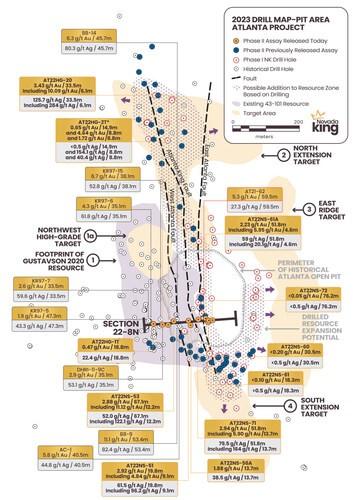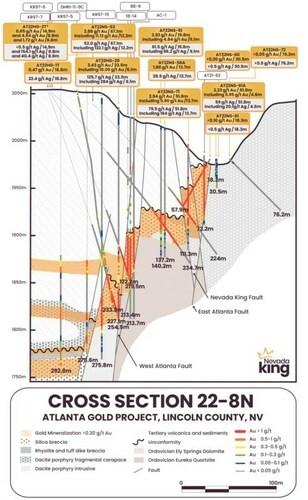
NEVADA KING INTERCEPTS HIGH-GRADE OXIDE GOLD AT ATLANTA INCLUDING 2.88 G/T AU OVER 67.1M, 2.95 G/T AU OVER 51.8M, AND 3.43 G/T AU OVER 33.5M
Nevada King Gold Corp. (TSX-V: NKG) (OTCQX: NKGFF) is pleased to announce assay results from nine reverse circulation holes and two core holes recently completed at its Atlanta Gold Mine Project located 264km northeast of Las Vegas, Nevada in the prolific Battle Mountain Trend. These holes on Section 22-8N were drilled across the high-grade feeder zone associated with several strands of a braided network of structures comprising the Atlanta Mine Fault Zone. The Company is currently drilling a series of fences across the AMFZ designed to get better definition of the grade distribution of higher grade zones correlated to the AMFZ (see Figure 1).
Highlights:
| Hole No. | From (m) | To (m) | Interval (m) | Au (g/t) | Ag (g/t) | Notes |
| AT22HG-20 | 207.3 | 240.9 | 33.5 | 3.43 | 125.7 | |
| includes | 233.2 | 239.3 | 6.1 | 10.09 | 284 | |
| AT22NS-53 | 157.0 | 224.1 | 67.1 | 2.88 | 52.0 | |
| includes | 205.8 | 218.0 | 12.2 | 11.12 | 122.1 | |
| AT22NS-51 | 89.9 | 109.8 | 19.8 | 2.92 | 61.5 | |
| includes | 93.0 | 102.1 | 9.1 | 4.85 | 96.2 | |
| AT22NS-71 | 36.6 | 88.4 | 51.8 | 2.95 | 79.5 | |
| includes | 54.9 | 68.6 | 13.7 | 5.90 | 164 | |
| AT22NS-61A | 6.1 | 57.9 | 51.8 | 2.23 | 59 | Bottomed in Mineralization |
| includes | 22.9 | 27.4 | 4.6 | 5.95 | 20.1 | |
| AT22HG-1T* | 274.1 | 292.8 | 18.8 | 0.466 | 22.4 | Bottomed in Mineralization |
| AT22HG-2T* | 176.8 | 191.8 | 14.9 | 0.65 | <0.5 | |
| and | 232.9 | 241.8 | 8.8 | 4.64 | 154.1 | |
| and | 256.1 | 264.9 | 8.8 | 1.72 | 40.4 | Bottomed in Mineralization |
Table 1: Highlight holes released today. Due to the multiple orientations of gold mineralization interpreted in today’s release, the Company has not yet estimated true widths for individual intercepts. *Denotes core hole.
- Holes released today tie into 2021 hole AT21-62, which returned 55m averaging 5.34 g/t Au starting at 9.1m depth on the east end of Section22-8N. These holes continue to encounter high-grade gold and silver mineralization, hosted in oxide material, tracking it to the west across the AMFZ where it remains open both to the west and to depth.
- Core holes AT22HG-1T and AT22HG-2T bottomed in Au-Ag mineralization at depths of 293m and 265m, respectively.
- Holes AT22NS-20 (33.5m of 3.43 g/t Au and 125.7 g/t Ag) and AT22NS-53 (67.1m of 2.88 g/t Au and 52 g/t Ag) penetrated the silica breccia zone directly above a fine-grained dacite porphyry dike that was also encountered south of this section along the western boundary of the West Atlanta Fault on Section22-6N (released January 6, 2023). Hole intercepts above and adjacent to this intrusive unit tend to host higher Au-Ag grades, and the volcanic section west of the intrusion is mineralized, unlike areas east of the intrusion.
- Mineralization in hole AT22NS-71 (51.8m @ 2.95 g/t Au and 79.5 g/t Ag) is hosted within silicified breccia that is sandwiched on top and bottom between mineralized porphyritic quartz latite tuff dike breccia bodies. Beneath the mineralized zone, AT22NS-71 cut down through barren dolomite, then through anomalous tuff dike breccia, and finally through the Atlanta King Fault and into quartzite. This lithotype sequence strongly suggests the AKF is serving as a conduit for channeling felsic dikes and dike breccia bodies into the silica breccia horizon. Higher Au-Ag grades are frequently found in the silica breccia proximal to these tuff dikes further south along the AKF. The Company is utilizing this close spatial relationship between these dikes and Au-Ag mineralization as an important exploration guide for finding higher grades as it advances the drills northward along the AMFZ.
Cal Herron, Exploration Manager of Nevada King, stated, “Section 22-8N is important for revealing two distinct zones of higher grade Au-Ag mineralization along the AMFZ – one coinciding with narrow fault blocks developed along the West Atlanta Fault, and the other occurring within narrow fault-bounded blocks formed in between the Atlanta King and East Atlanta Faults. This is most evident in the 13m-wide fault block drilled by historical holes 88-9, 88-14, AC-1 and KR97-6. The clustering of high-grade hits reported in these four holes (see Table 3) is highly unusual at Atlanta, but this is in part due to the unusually high hole density along this section. With this fault block so well defined, Nevada King is now in good position to track the high-grade structure along strike to the north and south. Similarly, the 30m wide fault block zone between the Atlanta King and East Atlanta Faults is becoming better defined and we are now able to track it along strike as well. This level of definition was not provided by historical drilling, and these new results will aid in accurate modeling of these high-grade zones.
“It is also important to note the close spatial relationship between the Atlanta King Fault, intrusive tuff dikes, and higher grade Au-Ag mineralization. We have already seen this relationship in other holes south of Section 22-8N, and has become an important indicator for tracking gold mineralization southward from the pit into the South Extension Target and beyond (Figure 1). The Atlanta King Fault is exposed along strike for about one kilometre south of the pit, however the downdropped block east of the fault that would potentially host mineralization is largely covered by quartzite scree and landslide debris, so the primary target of interest is not exposed. This area has never been drilled and exploration of this target will commence in May of this year after ground conditions improve.”
| Hole No. | From (m) | To (m) | Interval (m) | Au (g/t) | Ag (g/t) | Notes |
| AT22HG-1T* | 274.1 | 292.8 | 18.8 | 0.466 | 22.4 | Bottomed in Mineralization |
| AT22HG-2T* | 176.8 | 191.8 | 14.9 | 0.65 | <0.5 | |
| and | 232.9 | 241.8 | 8.8 | 4.636 | 154.1 | |
| and | 256.1 | 264.9 | 8.8 | 1.721 | 40.4 | Bottomed in Mineralization |
| AT22HG-20 | 207.3 | 240.9 | 33.5 | 3.434 | 125.7 | |
| includes | 233.2 | 239.3 | 6.1 | 10.093 | 284 | |
| AT22NS-53 | 157.0 | 224.1 | 67.1 | 2.879 | 52.0 | |
| includes | 205.8 | 218.0 | 12.2 | 11.124 | 122.1 | |
| AT22NS-51 | 89.9 | 109.8 | 19.8 | 2.919 | 61.5 | |
| includes | 93.0 | 102.1 | 9.1 | 4.845 | 96.2 | |
| AT22NS-56A | 93.0 | 106.7 | 13.7 | 1.876 | 38.5 | |
| AT22NS-71 | 36.6 | 88.4 | 51.8 | 2.945 | 79.5 | |
| includes | 54.9 | 68.6 | 13.7 | 5.900 | 164 | |
| AT22NS-60 | 0.0 | 30.5 | 30.5 | <0.200 | <0.5 | |
| AT22NS-61 | 0.0 | 18.3 | 18.3 | <0.100 | <0.5 | |
| AT22NS-61A | 6.1 | 57.9 | 51.8 | 2.227 | 59 | Bottomed in Mineralization |
| includes | 22.9 | 27.4 | 4.6 | 5.95 | 20.1 | |
| AT22NS-72 | 0.0 | 76.2 | 76.2 | <0.050 | <0.5 |
Table 2: All holes released today. Due to the multiple orientations of gold mineralization interpreted in today’s release, the Company has not yet estimated true widths for individual intercepts. *Denotes core hole.
| Hole No. | From (m) | To (m) | Interval (m) | Au (g/t) | Ag (g/t) |
| AT21-62 | 9.1 | 68.6 | 59.5 | 5.3 | 27.3 |
| KR97-7 | 211.9 | 245.4 | 33.5 | 2.6 | 59.6 |
| KR97-6 | 179.9 | 214.9 | 35.1 | 4.3 | 61.8 |
| KR97-5 | 164.6 | 211.9 | 47.3 | 1.9 | 43.3 |
| KR97-15 | 152.4 | 190.5 | 38.1 | 6.7 | 52.8 |
| DHRI-11-9C | 196.6 | 231.7 | 35.1 | 2.9 | 53.1 |
| 88-14 | 125.0 | 170.7 | 45.7 | 6.3 | 80.3 |
| 88-9 | 128.0 | 181.4 | 53.4 | 11.1 | 82.4 |
| AC-1 | 118.6 | 159.1 | 40.5 | 5.8 | 44.8 |
Table 3: Previously reported and historic holes used in Section 22-8N. AT21 series hole was drilled by Nevada King in 2021. The KR97 series holes were drilled by Kinross in 1997, the AC series hole was drilled by Goldfields in 1990, and the 88 series holes were drilled by Bobcat in 1988. Due to the multiple orientations of gold mineralization interpreted in today’s release, the Company has not yet estimated true widths for individual intercepts.
Qualified Person
The scientific and technical information in this news release has been reviewed and approved by Calvin R. Herron, P.Geo., who is a Qualified Person as defined by National Instrument 43-101.
About Nevada King Gold Corp.
Nevada King is the third largest mineral claim holder in the State of Nevada, behind Nevada Gold Mines (Barrick/Newmont) and Kinross Gold. Starting in 2016 Company has staked large project areas hosting significant historical exploration work along the Battle Mountain trend located close to current or former producing gold mines. These project areas were initially targeted based on their potential for hosting multi-million-ounce gold deposits and were subsequently staked following a detailed geological evaluation. District-scale projects in Nevada King’s portfolio include (1) the 100% owned Atlanta Mine, located 100km southeast of Ely, (2) the Lewis and Horse Mountain-Mill Creek projects, both located between Nevada Gold Mines’ large Phoenix and Pipeline mines, and (3) the Iron Point project, located 35km east of Winnemucca, Nevada.
The Company is well funded with cash of approximately $9.3 million as of February 2023.
The Atlanta Mine is a historical gold-silver producer with a NI 43-101 compliant pit-constrained resource of 460,000 oz Au in the measured and indicated category (11.0M tonnes at 1.3 g/t) plus an inferred resource of 142,000 oz Au (5.3M tonnes at 0.83 g/t). See the NI 43-101 Technical Report on Resources titled “Atlanta Property, Lincoln County, NV” with an effective date of October 6, 2020, and a report date of December 22, 2020, as prepared by Gustavson Associates and filed under the Company’s profile on SEDAR (www.sedar.com).
NI 43-101 Mineral Resources at the Atlanta Mine
| Resource
Category |
Tonnes
(000’s) |
Au Grade
(ppm) |
Contained Au Oz |
Ag Grade
(ppm) |
Contained Ag Oz |
| Measured | 4,130 | 1.51 | 200,000 | 14.0 | 1,860,000 |
| Indicated | 6,910 | 1.17 | 260,000 | 10.6 | 2,360,000 |
| Measured + Indicated | 11,000 | 1.30 | 460,000 | 11.9 | 4,220,000 |
| Inferred | 5,310 | 0.83 | 142,000 | 7.3 | 1,240,000 |

Figure 1. Location map for holes reported in this news release along drill section 22-8N relative to the perimeter of the historical Atlanta Pit and footprint of the Gustavson 2020 NI 43-101 resource. Shallow drillholes on the mine dumps have been removed from the plot for clarity. (CNW Group/Nevada King Gold Corp.)

Figure 2. Cross section 22-8N looking north across the southern portion of the Atlanta Mine Fault Zone. Shallow intrusive activity and closely associated gold mineralization are localized within the volcanic and sedimentary sequence along the western side of the West Altanta Fault. Higher grade mineralization is concentrated within narrow fault blocks formed between the East Atlanta and Nevada King Faults and along the West Atlanta Fault. (CNW Group/Nevada King Gold Corp.)
MORE or "UNCATEGORIZED"
Quimbaya Gold Closes $4 Million Financing and Expands Executive Team
Cornerstone investor brings proven regional track record; company... READ MORE
Spanish Mountain Gold Announces Larger Scale Preliminary Economic Assessment With a Base Case NPV5% After-Tax of C$1.0 Billion, 18.2 % IRR and 3.4 Year Payback at US$ 2,450/Oz Gold Price; at US$3,300/Oz Spot Gold Price NPV5% C$2.3 Billion, 32.0% IRR and 2.0 Year Payback; Including an Updated Mineral Resource Estimate for Its Spanish Mountain Gold Project
Spanish Mountain Gold Ltd. (TSX-V: SPA) (FSE: S3Y) (OTCQB: SPAUF)... READ MORE
Aura Announces Preliminary Q2 2025 Production Results
Aura Minerals Inc. (TSX: ORA) (B3: AURA33) (OTCQX: ORAAF) is plea... READ MORE
Cascadia Announces Closing of Financing
Cascadia Minerals Ltd. (TSX-V:CAM) (OTCQB:CAMNF) is pleased to an... READ MORE
Abcourt Closes US$ 8M Loan Facility to Start Sleeping Giant Mine
Abcourt Mines Inc. (TSX-V: ABI) (OTCQB: ABMBF) is pleased to anno... READ MORE













